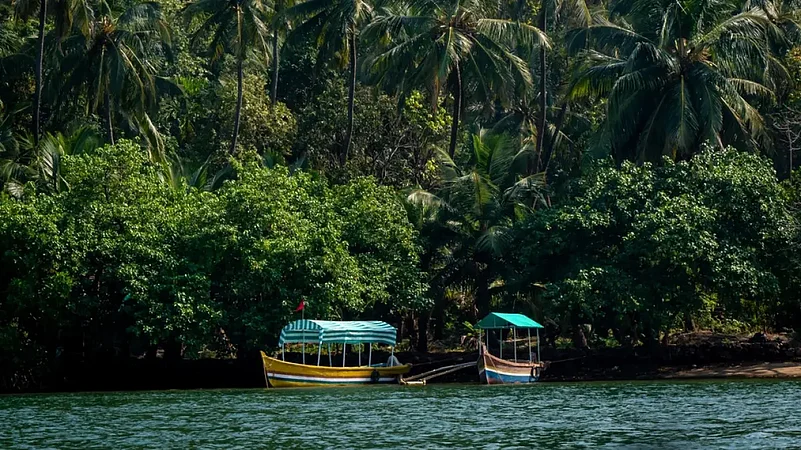Askote
Nestled on a ridge, this town got its name from ‘Assi Kot’, meaning eighty forts, that once reigned here. During December, the higher areas of the sanctuary are covered in snow. At an elevation of approximately 3,629 ft, with Panchuli and Chiplakot as a backdrop, Askote is the starting point for the annual Kailash-Manasarovar pilgrimage. It is famous for the Askot Musk Deer Sanctuary, home to the endangered musk deer. Askote is also known for some of the best skiing ranges, which are among the most highly recommended. This hamlet alongside the Kali river is a haven for nature lovers to pause, unwind and repeat. Travellers here will also find extensive rhododendron trees.
Devbagh
A perfect getaway offering mysterious sea and lush green palm trees with a clear, blue sky in complete sync. One can also engage in water sports here. Dress in comfortable shoes and clothes as the heat can be scorching during the day, even during winters. The calm sea, golden sands, and cool breeze make Devbagh a perfect getaway destination. Also famous for thrilling adventures like kayaking, parasailing, water-scooter, snorkelling, dolphin watching, this can be your choice among unconventional destinations to celebrate New Year’s in India. While in Devbagh, you might also want to visit the Sadashivgad Fort, set amidst dense forest, and the 1,000-year-old Shejjeswar temple.
Kaimur
Kaimur is one of the most important districts from the cultural and archaeological point of view. It is not only home to the famous Mundeshwari temple, but also to several other sites of archaeological importance, where apart from sculptural and architectural remains other antiquarian remains such as potteries, coins, inscriptions besides the most significant prehistoric rock paintings etc have also been found. In an exploration conducted in the year 1994-95 by archaeologists more than a dozen rock painting sites have been discovered in the Kaimur district. On the Kaimur hill the sites are at Mokwas, Patesar, Jhapia hill in the Chand block, Badki Goriya in the Makarikhoh valley in Bhagwanpur block besides Dugha, Hathiadag, Sarodag, Chaya, Badap Gaura hill, Rauta and Kokhargada in the Adhaura block which is located on the Kaimur plateau.
Daringbadi
Also called the Kashmir of Odisha, this beautiful valley can surprise you with snowfall in winters. Do not miss out on the pepper and coffee gardens here. Named after a British officer, Dering, who was the first to make this place his summer place, Daringbadi was initially known as Deringbadi (Dering’s village). Surrounded by lush green valleys, dense mountain forests, birdsongs, exotic plants, coffee plantations, pine trees, this off-beat location offers the ideal setting for relaxation and uninterrupted solace especially near the Doluri River. Discover the various tribal villages nestled in the forests during your trek. Don’t miss the Singari nacha by Kutia Kondhas, where the boy sings and dances to persuade his partner, and she answers through her performance
Roha
Located around 47 km from Mandvi, 51 km from the district of Bhuj, and about 127 km from the famous Rann Of Kutch in Gujarat, Roha is an offbeat destination sure to be a hit with history lovers and hikers. The fort stands at 800 feet above sea level on Roha Hill and overlooks the vast Roha town encircling it. The famous Gujarati poet Kalapi is believed to have spent a lot of time on this hill, penning many of his romantic verses. The serene and calm atmosphere of the place influenced the poet.
Chabimura
With ancient rock sculptures surrounded by dense forests and the mighty Gomati river, this place is a hidden gem. At Chabimura, the Gomati river descends from the Lushai Hills and enters into the plains. The turbulent flow subsides, and the river flows calmly, making it an ideal place for boating. Chabimura is also known for its ancient sculptures carved along the banks of the river. Dating back to the 14th and 15th century, these are dedicated to prominent Hindu deities like Shiva, Vishnu, Karthikeya, and goddess Durga. The Mahishasurmardini statue is the largest statue in Chabimura. It measures 12 meters in height and depicts the killing of Mahishasur, a demon king mentioned in Hindu mythology. The sculpture of Mahishasurmardini was astonishing in this setting. It portrayed Durga in her fearsome incarnation with ten hands, each carrying a weapon while Mahisasur lies on the ground at her feet.





















